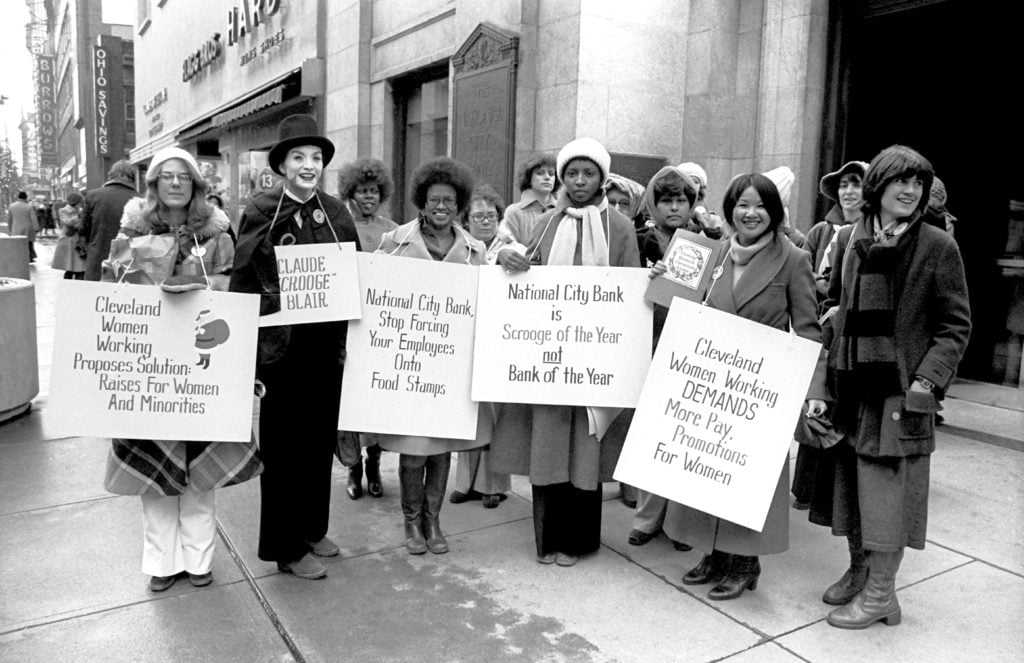A divisive and disgraced president. Wrenching shifts in the economy that leave millions of working people behind. A burst of social movement uprising. Recent events may feel unprecedented, but we’ve been there before – in the 1970s. A rogue president, Richard Nixon, was tearing the country apart. Democratic institutions were cracking. “The very fabric of government was falling apart,” according to Henry Kissinger, Nixon’s Secretary of State. Millions of people organized effectively for racial justice, women’s rights, gay rights, the environment and peace in Vietnam. Women organized as workers in a wave that changed work standards and opportunities, and the unions that many joined.
But the wave of organizing in the 1970s crashed in the 1980s. Activists then were not prepared for the corporate, right-wing backlash that would shape economic and political realities for the next two generations. What lessons can we learn so the 2020s are a period of breakthrough instead?
A new documentary by Academy Award winners Julia Reichert and Steven Bognar, 9to5: The Story of a Movement, draws inspiration and insight from the ‘70s vibrant office worker organizing. Twelve million women joined the paid labor force in that decade, at a time when “help wanted” ads were still segregated by gender. Women were concentrated in a handful of occupations, top among them secretary, bookkeeper and elementary school teacher.
I was a clerk-typist, one of 20 million women office workers, the largest sector of the workforce. As a political activist, it didn’t take me long to see that I could organize on the job, and along with others I started 9to5, the national association for women office workers, and our sister union, SEIU 925. We were part of a wave of organizing that swept across occupations: Stewardesses for Women’s Rights, women coal miners in the Coal Employment Project, the organization for sex workers called COYOTE (Call Off Your Old Tired Ethics), Women of Steel, the Coalition of Labor Union Women, and many more.
Breaking down barriers
At 9to5 we brought together women with high school diplomas and college degrees, broke down racial barriers, and paired young women with older women as activists. We picketed together in sensible heels and won millions of dollars in back pay and higher wages through unions they fought for and lawsuits they filed. We could have fun with our message – like the annual Bad Boss Contests – and were serious about power. Hundreds of thousands of women organized, millions cheered us on.
9to5 organizers were deliberate about building a multi-racial organization. Renia Clay, a member in Atlanta, remembers in the film how they brought women together. “I always credit Verna Barksdale [Atlanta 9to5 organizer]. She would always pair a Black person and a White person together. A younger person and an older person. And that helped form relationships in the organization.”
“There were definitely racial barriers to overcome,” Anne Hill says of a community college organizing campaign in Cleveland she ran. Carol Simms recalls being a Black organizer on a largely white campus in that campaign. “They said everything except I want a white organizer. They were hard core no’s. So I told them, we are negotiating for all. You can’t do it by yourself. We’re working class. You can’t walk away from this. You’re going to need it one day.” Hill and Simms won the campaign and united the workers.
Going after corporate power
9to5’s campaign against the Boston Survey Group in 1980 is an example of our widespread support, in-your-face tactics and sophisticated strategy. Debbie Schneider was a clerical worker at Cahner’s Publishing and the chair of 9to5’s Campaigns Committee when an anonymous temporary secretary tipped us off that a secret group made up of the 40 largest clerical employers was setting wages. Armed with information on when and where the employers were meeting, 9to5 members confronted company representatives as they walked into their monthly confab with boxes of key-punch cards containing the clerical wage data.
9to5 protested at Boston Survey Group companies, including the stockholders meeting of the Federal Reserve Bank of Boston, which compiled the statistics. We met with political leaders and filed an anti-trust complaint with the Massachusetts Attorney General. Our charge of wage fixing was the first of its kind – until then, anti-trust cases had only dealt with price-fixing. The Boston Survey Group settled, and some companies raised wages by 10 percent or more.
“I look back now on what 9to5 did by taking on the Boston Survey Group, and the multi- pronged strategy we developed to beat them, and I’m in awe of how gutsy we were,” Schneider recalls. “I was a 24-year-old clerical worker, and at the time, I didn’t think much about it.”
The first 9 to 5 movie
Our momentum grew with Jane Fonda’s 1980 movie 9 to 5, which was inspired by our organizing and shaped by conversations Fonda had with 9to5 members in Cleveland, Ohio. But our growth coincided with a corporate crackdown on unions and a right-wing backlash seen in organizations like STOP ERA and the Moral Majority. Activists from the 1970s were not prepared for the 1980s radical re-organization of work, and the consolidation of right-wing power in politics which shaped reality in the U.S. for the next two generations. Today working families are worse off now than they were 50 years ago. Racial injustice permeates society. A climate crisis threatens our very existence. Women became individually self-reliant, but without effective organizations, we were powerless.
Jimmy Carter’s presidency in the late 1970s was not a move towards a more equitable society, but merely a pause in the reign of a new Right. Our challenge today is to make the 2020s look very different. We know better now. The American public broadly agrees that our economy is failing working people. The logical consequence of right-wing politics is playing out in front of our eyes. Black Americans are forcing a reckoning with centuries of racism. The pursuit of profit above all else is driving our planet to collapse. We do know what we are facing. We should be prepared.
The lessons from 1970s working women’s organizing speak to us today. Find common ground across race and class. Develop leaders and build mass-based, democratic, self-sufficient organizations from the bottom up, with strategies to take on corporate power. Don’t accept symbolic gestures and individual opportunity when systemic economic change is what is required. The Biden presidency cannot be a respite. It has to be a turning point. We don’t have many chances left.
“There’s so much to do,” Jane Fonda says in 9to5: The Story of a Movement. “And women will lead the way.”
Renia Clay became a lawyer representing youth in the foster care system. Anne Hill worked at SEIU 925, then in politics and health care representing the needs of working class communities. Carol Simms was an SEIU organizer until she retired. Debbie Schneider went on to become the national president of SEIU 925 and a top leader at SEIU on global organizing and leadership development.
9to5: The Story of a Movement is available for free through March 3, 2021 on local PBS affiliates and the PBS website. Check your local listings for details.
Did you enjoy this article?
We're in the middle of our annual fund drive, and this year we're building our own internal infrastructure for subscriptions, meaning more of every dollar pledged goes to fulfilling our mission. Subscribe today to support our work and be a part of Convergence's next evolution.

